
When the weather warms up in March I start thinking about fishing a few open matches. I am relatively new to match fishing and started at the local Maidstone Victory club in 2003, by 2005 I started to turn my attention to commercial opens.
Two methods I worked hard to get right gave me successes, one was fishing shallow on the pole, the other was the pellet waggler, this is my favourite method to catch carp and what I will write about today. Having fished the waggler for 30 years on lakes and rivers the method came easy to me.
In a match at Framfield on a difficult day, I more than triple the weight of the pole anglers either side of me. That’s how good it can be.
I will start with the tackle I use for the method, rod wise you need something with a through action, not to stiff in the tip but with power in the middle. Length is a personal preference but I like to use a shorter rod as the venues I fish are quite small with 30 metres the maximum casting range. I find the 11ft Carbonactive is perfect for the job and I have two, the 3 piece and the slightly more powerful 2 piece. If you prefer to use something longer you can’t go far wrong with the 12 or 13 ft Maver Reactolite, a good budget buy for the method is the 11ft Milo Premiership Prestige Ultralight Float or the Shakepere Match 3 range, but lots of other rods that will do the job and your current float rod would probably be OK.
Reel wise you want something with a bit of power, a reasonably large spool and not too fast a retrieve, my choice is the Daiwa TD-Sol 2500, This is a model from the States but is more or less the same reel as the Daiwa TD-R but orange in colour! Again it is personal preference and what you can afford but several will fit the bill. If you have a limited budget I would take a look at the Shakespeare Match 3 range. The reels will be loaded with 4lb(0.20mm) Mr Crappie line brought from Bass Pro in the States. I find this line perfect for the job and at $7.49 for 3000 meters a real bargain. But any supple line of about 4lb B/S (0.18-0.20mm diameter) will be OK.
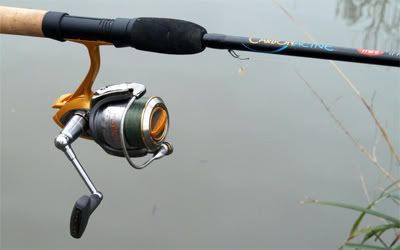
My favorite Carbonactive rod and Daiwa TD reel combination for the method.
Now down to the important part, the rig. First of all I do not like the loaded straight balsa type floats that seem to be very popular, they dive too deep on the cast spooking fish so are best avoided. I use a selection of straight unloaded (pellet) wagglers my favourites being my home made Styrofoam and light balsa ones. I carry these in a range of sizes from 2AAA to 4SSG. I also use the thickest bodied clear Drennan Puddle Chuckers if the fish are a bit spooky at the start of the days fishing. There are perfectly good commercially available wagglers available and most shops now will sell a selection of Styrofoam and Balsa floats in a good variety if sizes.
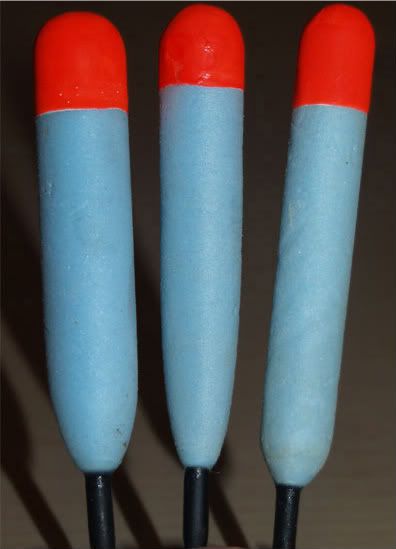
Styrofoam Wagglers.
You seem to see a lot of complex ways of attaching the float but I keep thing simple by locking it on the line with shot just above the trace, I use at least 2 each side so it doesn’t move, doing things this way it is easy to quickly change depth if needed. Trace wise I use Fox Micro Plus line in 0.14-0.20mm depending on the size of fish and time of year, these are all tied up at 12 inches long. The hook is a Drennan carp eyed or Fox carp attached by a knotless knot. The bait will be hair rigged and this is done by tying a Gardener 3.2mm bait band to the hair then you can easily slip any size pellet from 6-12mm in it, I don’t like to drill and hair rig pellet as I find they tend to swell and split, also I have better thing to do in the evening!. I tie all the hairs up at the maximum length I am likely to use then you can easily shorten them by winding the line around the hook bend if needed.

The rig.
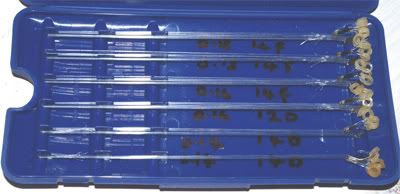
I always carry plenty of made up hooklengths.
Don’t forget the catapults; I carry 5!! 3 Fox River ones with the thick Pink elastic and 2 Drennan Match with the red medium soft elastic for shorter range. These are all fitted with a mesh pouch.
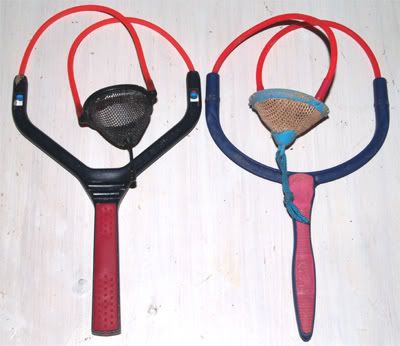
The cattys I use.
Now on to the feed pellets and these you will need plenty of, on the waters I fish it is not unusual to get through 8 pints or more of pellets some days. I like to use Skretting coarse pellets in 6 and 8 mm for feed, these are brought in bulk 25 kilo sacks from the local fish farm but are available from several places mail order. You need a low oil pellet that will fall through the water relatively slowly, avoid halibut, trout or any high oil pellet as they sink like stones and are no good for the method. If you are buying your pellets from a tackle shop I would recommend the Dynamite Swim Stim Amino Original pellet but this can be an expensive way to buy them. I will also quite often feed some pumped expander as these make a lot of noise when hitting the water and you can control the speed they sink by the way you prepare them.

A selection of pellet hookbaits.
For hook bait I like to use 90% of the time the same pellets as the feed, but I also have a couple of tricks that can get you catching on difficult day or early on in the session before the fish are really having it. One is to wrap the pellet with a small amount of paste made by grinding the same pellets you are feeding. You need to mix the paste up on the dry side like a method feeder groundbait mix so it "melts" off the pellet producing a nice cloud that hangs in the water drawing fish up to the hook bait, quite often this will produce bigger fish. The other is to use a floating expander on the hook, using the correct weight of hook you can get a very slow fall of the bait through the water and this can be a devastating, the other benefit of fishing a slow sinking bait is it is spending more time falling through the water in the “catching zone” so to speak.
I will now share with you a days fishing at Hartleylands Farm fishery where last summer I won a two day festival fishing the pellet waggler, this water is made up of 8 lakes and ponds that offer superb fishing for all species, but importantly they hold good number of carp from a pound running well into double figures, this is a ideal water that will responds well to the method.
I have settled in a swim on Pear Tree Lake, one of the 3 match lakes on the fishery, I am on peg 6 opposite one of the two islands at the lake, a cast of around 20-25 meters is needed so I have selected a 4.5AAA pellet waggler. It’s around 6 foot deep but I will start off at a depth of 2 foot today, I find this is a good starting point here. Feed for today will be 6mm coarse pellets, I will use this size if I can as some will hang momentarily in the surface film all falling through the water at different speeds. To keep your casting as accurate as possible it is a good idea to clip up at the distance you are fishing; I will do this early on in the session until I get a feel for the distance especially as I am fishing towards a reedy island margin today.
In a match it can be a good idea to feed the swim for a while to get the fish feeding confidently before casting your float and fish the pole for a while instead, in a 5 hour contest I have left the waggler line for up to 2 hours before fishing it. As it is a pleasure session today I have been firing out about 10 pellets about every 15-20 seconds while setting up my gear so by the time I cast hopefully they will be feeding well.
Now for the first cast of the day, I fired another 10 pellets into the swim followed by the float, I will let it sit for about 20-30 seconds until the bait hits the bottom of the drop. Then if no bites are forthcoming I will feed again slightly short of the float dragging it into the feed allowing the bait to fall through the water again, the idea of this is to simulate the way the pellets are falling through the water. This cast produces a bite and a slight sideways strike connects with an angry small carp. Keep the rod low and to one side and you can reel most fish into netting range without too much trouble, once the fish is under control trap the rod between your legs and feed the swim again to keep the remaining carp interested, net the fish then start all over again by feeding, then casting etc.
Here is a sequence of photos to demostrate
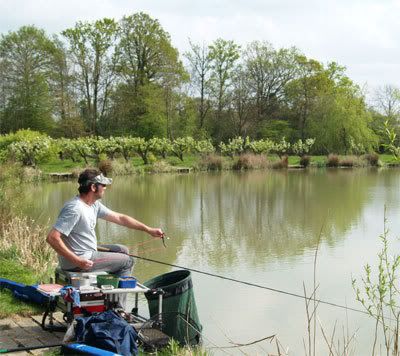
Feed the swim.
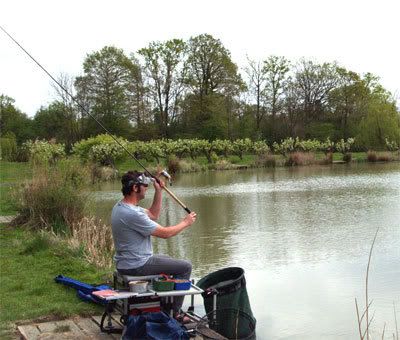
Cast.
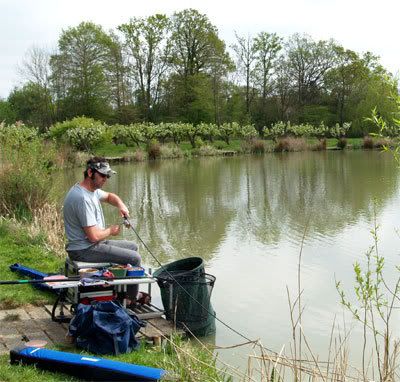
Strike! The fish is on.
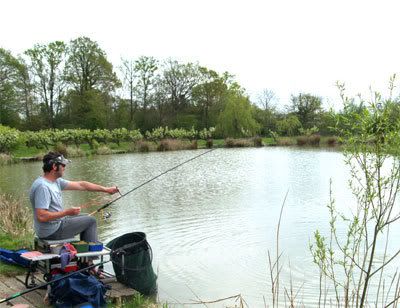
Feed again when the fish is in netting range.
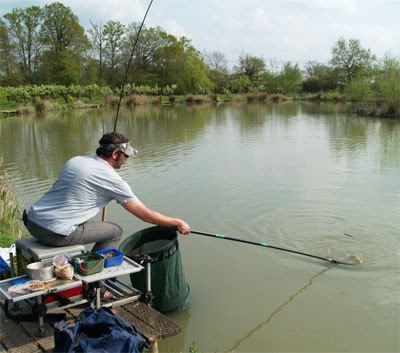
Net the fish and start again.
It is important to get a rhythm going, you should be continuously casting, feeding, twitching the float, and it is a very busy method.
As the session progresses you will need to work out the how much and how often to feed, there are no hard and fast rules and I’m afraid you will have to experiment yourself, some day it will be a few pellets every 10-20 seconds or so, others they will want a big pouch full. On the day I was fishing they responded best to about 10 pellets every 15 seconds. Although I caught well on 6mm banded pellet early on wrapping it in paste got me a bite in half the time. After about a hours fishing the carp were gaining confidence and this wasn’t needed as the plain pellet was taken just as quickly.

The most productive bait early in the session was paste
The depth you fish is also critical and a few inches can make all the difference, I find the more often you feed the higher the fish will rise in the water, ideally I like to catch at around a foot deep so adjust the feed rate to match. If you start to foul hook fish it will pay to shallow up. Alternatively if you are getting no bites at all the fish may be down deeper. If you are missing fast bites, this could be because you are fishing too deep and fish are brushing the line, on the other hand you could be fishing too shallow and the fish are rising in the water and grabbing at the bait. If this happens deepening up a little will result in more positive bites.
Something else worth a mention is how the float lands on the water, this can make a big difference, feathering the line to get the bait to land beyond the float can be best some day. On other it is more productive to let it all land in a heap making a big splash, hold on to the rod if they want it this way as bites can be savage!
I ended the 4 hour session with around 60 carp for a 100lb plus catch.

Part of the days haul.
Next time you have a trip to your local commercial leave the pole at home and give the pellet waggler a try. I know I will be using the method a lot this summer.
(photos taken by Deborah Gilbert)
Venue Info
Hartleylands Farm
Swattenden Lane
Hartley
Cranbrook
Kent TN17 3PS
http://www.hartleylands.co.uk/